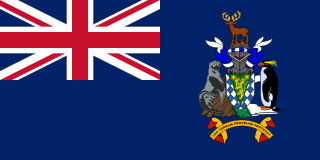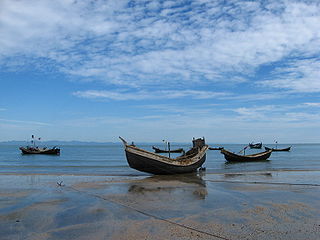
South Georgia and the South Sandwich Islands (SGSSI) is a British Overseas Territory in the southern Atlantic Ocean. It is a remote and inhospitable collection of islands, consisting of South Georgia and a chain of smaller islands known as the South Sandwich Islands. South Georgia is 165 kilometres (103 mi) long and 35 kilometres (22 mi) wide and is by far the largest island in the territory. The South Sandwich Islands lie about 700 kilometres (430 mi) southeast of South Georgia. The territory's total land area is 3,903 km2 (1,507 sq mi). The Falkland Islands are about 1,300 kilometres (810 mi) west from its nearest point.

St. Martin's Island is a small island in the northeastern part of the Bay of Bengal, about 9 km south of the tip of the Cox's Bazar-Teknaf peninsula, and forming the southernmost part of Bangladesh. There is a small adjoining island that is separated at high tide, called Chera Dwip. It is about 8 kilometres west of the northwest coast of Myanmar, at the mouth of the Naf River.

The Salish Sea is a marginal sea of the Pacific Ocean located in the Canadian province of British Columbia and the U.S. state of Washington. It includes the Strait of Georgia, Strait of Juan de Fuca, Puget Sound, and an intricate network of connecting channels and adjoining waterways.
Arturia canariensis, commonly known as the yellow calcareous sponge, is a species of sponge in the family Clathrinidae. It is found in shallow seas in the Canary Islands, Cape Verde, the Adriatic Sea and the Caribbean Sea. The specific epiphet "canariensis" was given to this species because it was first described from Lanzarote in the Canary Islands.

The wildlife of Antarctica are extremophiles, having to adapt to the dryness, low temperatures, and high exposure common in Antarctica. The extreme weather of the interior contrasts to the relatively mild conditions on the Antarctic Peninsula and the subantarctic islands, which have warmer temperatures and more liquid water. Much of the ocean around the mainland is covered by sea ice. The oceans themselves are a more stable environment for life, both in the water column and on the seabed.
Clathria rosita is a species of sea sponge first found on the coast of South Georgia Island, in the southwest Southern Ocean.
Clathria stromnessa is a species of sea sponge first found on the coast of South Georgia island, in the south west Southern Ocean.
Clathria matthewsi is a species of sea sponge first found on the coast of South Georgia island, in the south west Southern Ocean.
Lissodendoryx collinsi is a species of demosponge first found on the coast of South Georgia island, in the south-western Southern Ocean. The discovery of Lissodendoryx collinsi and 14 other new species resulted in increasing the previously reported low sponge endemicity off South Georgia.
Hymedesmia barnesi is a species of demosponge first found on the coast of South Georgia island, in the south west Southern Ocean.
Iophon husvikense is a species of sea sponge first found on the coast of South Georgia island, in the south west Southern Ocean.
Hymedesmia pharos is a species of demosponge first found on the coast of South Georgia island, in the south west Southern Ocean.
Myxilla ponceti is a species of demosponge first found on the coast of South Georgia island, in the south west Southern Ocean.
Tedania wellsae is a species of sea sponge first found on the coast of South Georgia island, in the south west Southern Ocean.
Mycale brownorum is a species of demosponge first found on the coast of South Georgia island, in the south west Southern Ocean.
Mycale cartwrighti is a species of demosponge first found on the coast of South Georgia island, in the south west Southern Ocean.
Haliclona crowtheri is a species of demosponge first found on the coast of South Georgia Island, in the south west Southern Ocean.
Microxina myxa is a species of sea sponge first found on the coast of South Georgia island, in the south-western Southern Ocean.
Calyx shackletoni is a species of sea sponge first found on the coast of South Georgia island, in the south-western Southern Ocean.
Sponge grounds, also known as sponge aggregations, are intertidal to deep-sea habitats formed by large accumulations of sponges, often dominated by a few massive species. Sponge grounds were already reported more than 150 years ago, but the habitat was first fully recognized, studied and described in detail around the Faroe Islands during the inter-Nordic BIOFAR 1 programme 1987–90. These were called Ostur by the local fishermen and this name has to some extent entered the scientific literature. Sponge grounds were later found elsewhere in the Northeast Atlantic and in the Northwest Atlantic, as well as near Antarctica. They are now known from many other places worldwide and recognized as key marine habitats.



